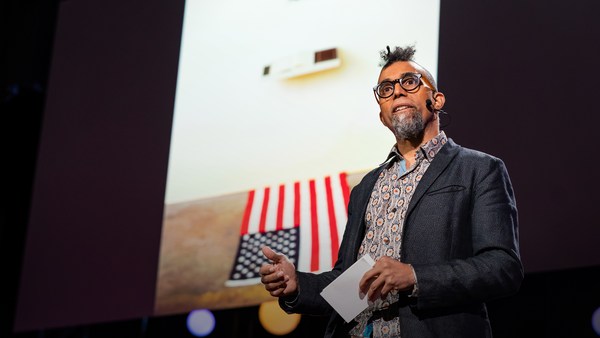In 1989, an artist by the name of Dread Scott, who has also graced the TED stage, created a piece of art in Chicago, where he simply placed an American flag on the ground and then invited you the viewer to go and stand on that flag and record how it felt in a journal. And to me, one of the most powerful things written in that journal, in essence, says, "Why are we so OK with homeless people, with human beings laying on the ground, but not flags?"
And to some of you, this piece of art is quite disturbing. And that's kind of the point of this talk -- not to upset you or to make you mad but to prove to you that flags have an incredible power, and that even if you think you don't care about flags, you do. You know you do. Alright.
By the end of it, I hope that you're inspired to go out and harness this power of flags and fight for a better world. But before we get there, we're going to start on the opposite end of the spectrum. And before I show you the next stuff, I need to say that anything I show here is not an endorsement, it's usually quite the opposite. But more than anything, what I want to do is create a space here where we can look at these flags, these designs, and examine how they make us feel. We're going to talk about our emotions. Is that OK with everybody?
OK. Are you ready for your first flag?
Cool, we'll start with an easy one. That was a joke. (Laughs) So, some of you may be a little bit uneasy sitting in a room with this. I'm certainly feeling uneasy standing in front of it. Some of you may be feeling a little bit of pride. And that's understandable. This is Texas. This is not a rare sight, is it?
But let's start with the facts. So this is not the Confederate flag. OK? This is the battle flag of the Army of Northern Virginia led by General Robert E. Lee. So next time someone tells you that this is their heritage, unless their family fought for that very specific militia, they're wrong, alright? And you have a flag expert's permission to tell them so. This flag rose into prominence during the mid-1950s and '60s as a response to the growing Civil Rights Movement. And then of course today, it has come to represent the Confederacy to most of us. But I shouldn't have to remind you what the Confederacy is. It was a rogue nation that rose up against the United States, waged war on the US, and at one point in time, this was one of the most un-American things you could have. But yet, this flag is protected by the same laws that protect the United States flag in the states of Florida, Georgia, South Carolina, Mississippi and Louisiana.
But let's pick on Georgia for a second, shall we? So in 1956, a few years after desegregation was mandated in public schools, Georgia changed their state flag to this. I think everyone watching can agree that this was not meant to be a flag that every Georgian was proud to fly outside of their home, was it? No. Just like all of the Confederate statues erected in the mid-1950s and '60s, this was meant to be a symbol of who was in charge and who was not. This remained the flag of Georgia until the year 2001, and in that year, they changed their flag to this. Now, as a flag expert, I can tell you: this is officially ugly. OK? It's OK to laugh at this flag. It's ugly, and because it's so ugly, that's one of the reasons they changed it just two years later. They had a referendum where they got to choose between that thing and then what is now the current flag of Georgia.
Now some of you might be wondering, "Wait a second, Michael -- if that before wasn't the Confederate flag, what was the Confederate flag?" Georgia flies the first flag of the Confederate States of America to this day. They just slapped their state seal on it.
Well, let's go back to our emotions for a second. That didn't punch you in the gut as much as the other one did, did it? Right? And that's why I love flags. They are the simplest pieces of design, usually just two or three colors, just some bars or stripes. But yet, they can invoke the deepest emotions within us. They'll make us swell with pride or burn with hatred. We will die for a flag or even kill for one.
One of my favorite designers, his name is Wally Olins, they call him the father of nation branding, and he's quoted as saying that "Everyone wants to belong, and then they want to display symbols of belonging." And it's crazy that these pieces of cloth that are just sewn together or dyed come to be such a sacred item, and that's because they become parts of our identity. They are powerful tools to unify but equally powerful tools to divide.
You ready for the next flag? Right. Take a moment. Really examine how you felt when this hit the screen. I'm going to change the slide pretty quickly so you don't take pictures of me in front of this one.
(Laughter)
Alright?
So Germany after World War I, it was in a pretty bad state, and a young Adolf Hitler had a lot of -- let's call them -- "ideas," of how Germany got to where they'd gotten and how to get them out. He spent entire chapters in his book "Mein Kampf," which I don't recommend reading, about how Germany lost World War I partially because the British had better graphic design and better propaganda.
So, as the Nazi Party rose, Hitler created one of the thickest brand guides I've ever seen. It's thicker than most company brand guides today, and in it, he details titles and uniforms and lots and lots of flags. Hitler knew the power of flags. He says in "Mein Kampf," "The new flag ... should prove effective as a large poster, [because] in hundreds of thousands of cases a really striking emblem may be the first cause of awakening interest in a movement." He was an artist, after all. He knew the power of visual identity and uniforms could reignite the German identity. And to millions of Germans, this was a welcome sign. But of course, this was also a mark of death to others.
We don't often think of flags as weapons, but like the Confederate battle flag, the Germans used their flag to make an out-group feel unwelcome and less than. You see, when you create a flag, you immediately do two things: you create an in-group, a group that's meant to be represented by the symbol, but then, inevitably, you create an out-group. And usually, that's subtle. It's a byproduct. It's usually not the intent. But the Germans were very clear as to who was represented by the swastika and who was not.
In 1935, Jewish people were banned from flying German flags. And in this way, the Germans, maybe more than any other time in history, used the dual power of flags to unite but also to divide. Flags were used as identity weapons. And now, in 2019, the Nazi flag is banned from being flown by anyone in Germany and anyone in Austria, in Hungary, in Russia and in Ukraine. Think about that. It's a piece of cloth, but it's banned. On its face, that sounds crazy. But I don't think anyone in this room would disagree that it's probably good. Sounds a lot like a weapon.
As a vexillologist, sometimes the most interesting thing about a flag is not so much its design, but it's those laws around the flag. For instance, in India, to create an Indian flag, you must use a hand-spun cloth named "khadi." If you make a flag out of anything else, you could go to jail for up to three years. It's crazy. Here in Texas, we've all heard that the Texas flag is the only state flag that can fly at the same height as the US, flag, right? Because we were a nation before we were a state. Who here has heard that? Yeah. Well, I'm here to tell you that is completely false. OK? First of all, we were not the only state that was a nation before joining up. And secondly, all state flags can fly at the same height as the US flag according to the US flag code.
And I don't have to ask you how you feel about this one, right? Most of us grew up pledging allegiance to this every morning, knowing we should never let it touch the ground, etc. We take our flag code very seriously here in the United States.
You remember, recently some NFL players kneeling during the national anthem. It was a big controversy. They were breaking the flag code. It states during the national anthem, stand at attention, hand at the heart, etc. But what was fascinating to me as a vexillologist is that I didn't see anyone getting upset when something like this happens. The flag code says, "The flag should never be carried flat or horizontally, but always aloft and free." So sometimes during the exact same national anthem, this was being done, and no one's upset. Or this. This happens all the time. The flag code is clear: "No part of the flag should ever be used as a costume or on an athletic uniform." This is Texas A&M baseball, not to get them in trouble, but this happens all the time, especially in November. I'm sure, I can almost guarantee when you leave here tonight, you will see on the back of someone's car or truck a black and white American flag with a blue stripe, a thin blue line, right? Blue Lives Matter. That breaks the flag code in multiple ways.
But all of these things are done with the best intent. No one's here to argue that. But of course they break a section of the flag code titled "Respect for the Flag," so by putting this on your uniform, you are legally disrespecting the flag. And what I find interesting is that those NFL players kneeling during the anthem and the people who would put Blue Lives Matters stickers on their car are both on the opposite end of a very big issue, but they're both breaking the exact same law, a law that is 100 percent unenforceable. In fact, it was Dread Scott's piece of art in 1989 that led the Supreme Court to rule that the flag code is just a guideline. You cannot be prosecuted for breaking the flag code. You cannot be forced to be patriotic.
So why, then, have all of these little laws around how we use our flag if you can't enforce them? And that's because a nation is a fragile collective idea. It only exists in our minds. Can I see this? Thank you. Sometimes a flag is the only tangible symbol of that idea. Right? Our unity is sometimes only held together by literal threads. And that's powerful. The flag code is meant to preserve and protect that fragile idea, while also protecting your right to break it. And that's what's special about the United States, right?
And that's what's unique about our flag. Our flag is amazing. It has changed more than any other flag in the world. It's the flag code that says when a new state is created, a star shall be added to the union of the flag, and such addition shall take place on the fourth day of July. Our flag is unique because it is meant to grow as we grow. By design and by law, it is meant to change with us. It's a living symbol of our individuality, our diversity in the stars and our unity. We have a gift in the United States to have a flag that is inclusive. If the Nazi flag was an identity weapon, the United States flag, by design alone, stands in direct contrast. And I have to say, as a vexillologist in 2019, using this flag as an identity weapon against anyone disrespects it far more than letting it touch the ground or any one of the other little laws that we break every day. Right?
This flag is a symbol of our unity. We should never use this as a weapon against someone else. I resonate so deeply with the person who wrote in Dread Scott's journal, "We should never value the symbol over the thing that it symbolizes. We should never value a piece of cloth over a human life." And if you're ever going to use a piece of cloth as a weapon, you should never use this one, not when it has always had room for more stars.
Hopefully by now, you've felt the power of flags, and you can see what they can do. So what if we harnessed that power, and we used it to fight for something greater? This is the flag of Earth, designed by Oskar Pernefeldt of Sweden. Just imagine with me for a second: What if we celebrated our humanity as much if not more than we celebrate our nationalities? As we become a spacefaring civilization and we go off into the stars, what do our nations mean anyway when you're standing on the surface of Mars or any other planet? And then of course, back here on Earth, as our planet is facing a climate crisis, as our climate could be unlivable in our children or grandchildren's lifetime, I believe we need a strong symbol, a flag, to unite us to fight, not just as nations, but as a species.
Thank you.
(Applause)





